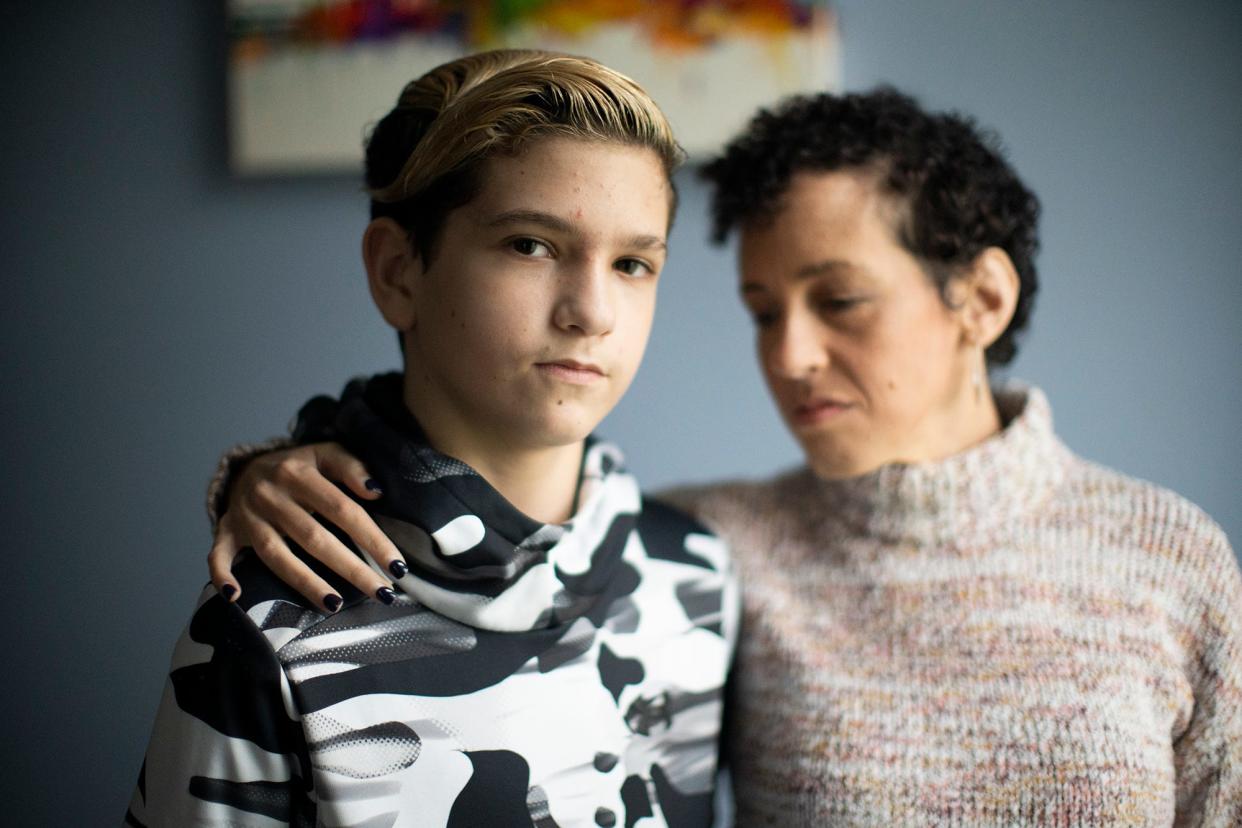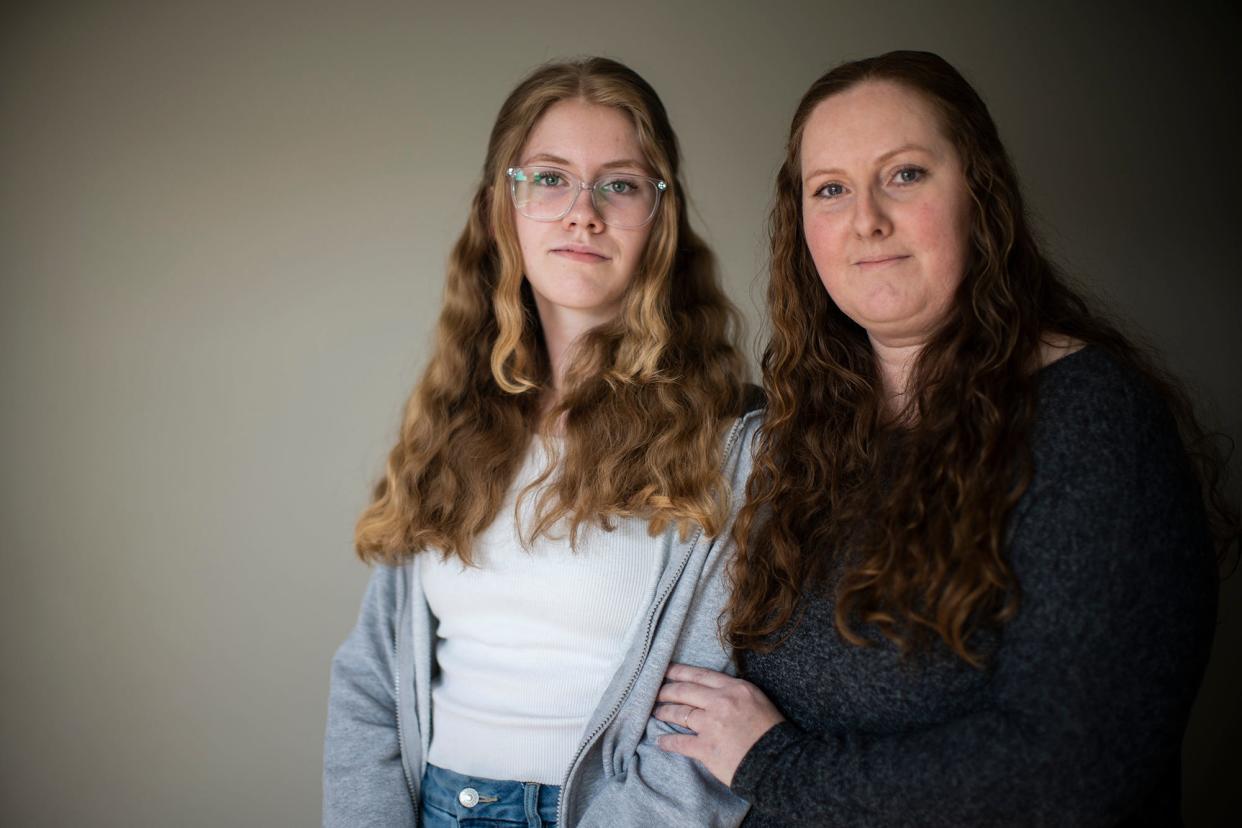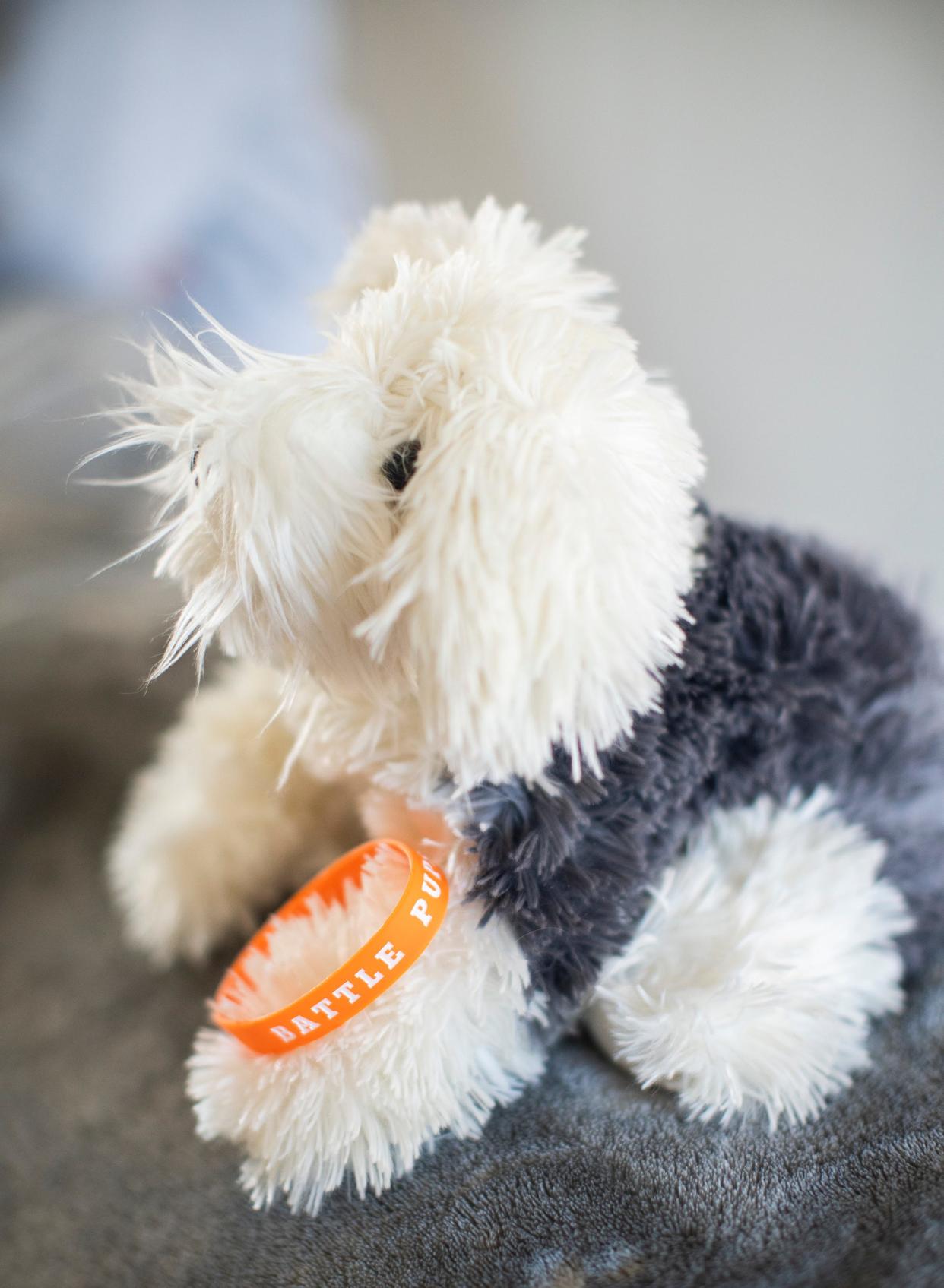'Not how school is supposed to be.' Pickerington students open up about shooting incident

"Lockdown! Lockdown!"
Eighth grader Cameron Witters was in third-period English class just before 10 a.m. Feb. 2, when the announcement blared over the loudspeaker at Pickerington Ridgeview STEM Junior High School.
"We panicked and got down on the floor. I was thinking, 'Is this a drill?' I didn't know what to think at that point; there was so much going through my head," the 14-year-old said, sitting with his parents, Jim Witters and Jaime Bender, in their Pickerington home in an interview with The Dispatch.
Cameron helped move a table in front of the door and stacked a desk on top of it. When his teacher began handing sharp objects to the students to throw, if necessary, the young student realized the gravity of the situation.
"Usually, you don't do that during a drill," he said. "I just grabbed the first thing I could find in my backpack, which was my friend's water bottle."
From Feb. 2: Pickerington Local closes all schools after adult died by suicide at Ridgeview
Gun and other violence: Ways parents can help their children cope after traumatic events
A well-spoken teen with precociously acute perception, Cameron, now a freshman at Pickerington High School Central, said he was willing to try to protect his classmates if it came to the worst-case scenario — facing an armed individual.
"If somebody came (in) the door, I'd be the first one to throw something," he said. "I was ready to act before anybody."
Cameron and his peers did not have to face an active shooter that day; an adult relative of a student fatally shot himself in an office. But the incident had a significant impact on students and their families.
"Kids don't have to be the victims directly for it to be traumatic. It's still an adverse childhood experience," said Ariana Hoet, a pediatric psychologist at Nationwide Children’s Hospital.

The trauma of exposure to gun violence — whether as eyewitnesses or as indirect victims like Cameron in their schools or communities — can manifest itself in a number of reactions, both physically and emotionally, Hoet said.
"Kids are human; they aren't robots."
"They might have difficulty sleeping, nightmares and intrusive thoughts because they think about what happened. They might become withdrawn and don't want to go to school," she said.
"This is all normal after a scary event."
Under Fire: A Columbus Dispatch investigation into gun violence in Greater Columbus
Emotional issues, changes in sleep patterns and other aftereffects persisting beyond a couple of weeks after a gun-related incident could indicate a more concerning mental health crisis, Hoet said.
"If a child is still showing these symptoms and they get in the way, that’s when we start worrying about (post-traumatic stress disorder), which can impact their academic success and even last way into adulthood," she said.
Annie Andrews, senior adviser at national groups Everytown for Gun Safety and Moms Demand Action, said the problem of gun violence and active shooter drills and other ways in which districts have responded are depriving children of the right to feel secure at all schools across the country.
While the short-term effects, she said, can include decreased school performance, decreased attendance and mental health issues, the long-term effect is that children are being sent into a place where they no longer feel safe.
"They're being robbed of that," she said.
'I was so scared'
Listening to her son's retelling of the lockdown at school, Bender regarded Cameron with a mix of admiration for his instinct to protect others and relief that he was safe.
"That's a lot of pressure to put on young kids," she said. "(School) is supposed to be their safe haven. It's some kids' only haven. This feels like a breach. No parent, no child wants to feel like they can't be safe in their own school."
The Dispatch reached out to Pickerington Local School District administrators numerous times for comment about the Feb. 2 incident, as well as what, if any, safety measures or active shooter training were in place at the schools. An email statement from a spokesperson said, "The district will not be (discussing) the Ridgeview incident anymore."
'We had to be very quiet': Pickerington cafeteria worker sheltered in place for lockdown
While Cameron and his classmates hunkered down in their classroom, Kayla McCoy, 13 at the time, was fleeing the school cafeteria.
"A lunch lady came running through, yelling at us to be quiet," said Kayla, now a 14-year-old freshman at Pickerington High School Central. "Then there was an announcement that we were in lockdown and (lead assistant principal Henry Lee) was saying, 'Run, run … everybody get out, go!'"

As she ran, Kayla's initial thought was: "'There's an active shooter going to shoot all of us.' I really thought there was going to be someone shooting at us, trying to hurt us. I was so scared."
When the students were safely out of the cafeteria, Kayla borrowed a friend's phone, her own having been left behind in panic and haste, and was able to talk to her mother, Vicki.
"Kayla was frantic, saying something about an active shooter and that she was outside," Vicki McCoy said. "And that was it. The call ended."
McCoy hopped into her car and headed to the school. Once there, she heard a male voice on the loudspeaker.
"I could tell it was an authority figure … telling them, 'You're safe,' so they could listen to him for instructions."
Students also heard that voice.
"They said, 'All students are safe, all staff are safe,' there was no active shooter," Cameron said.
The tragic truth comes out
Cameron and his classmates searched for news reports on their phones as rumors and the word "suicide" were bandied about.
"I was checking the news stories, and it was confirmed that it was a suicide at my school," he said. "I was kind of confused about what the context was behind that. I was just like, 'Why would he do that and why to himself?'"
Bender, who also saw early news reports, said her first instinct was "get your child out of there," but parents were instructed to not come to the junior high as students were not being released there.
While parents waited anxiously, details about the incident began to emerge in the news.
According to a police report, a detective responded to the junior high earlier that morning after school staff reported allegations of a "possible criminal act" by a relative of a student.
Talking to kids: Here's how parents can talk to children about gun violence
A school resource officer said the student's mother and stepfather were already at the school for an unrelated meeting and was advised to separate the stepfather from the student and her mother to find out more details about the allegations. Pickerington Police Detective Tim Planck responded to provide assistance.
About 50 seconds into a conversation with Planck in a private administrative office, the stepfather pulled a firearm from his waistband and shot himself in the head. Hearing the gunshot, the SRO quickly called for a lockdown.
'Not how school is supposed to be'
Once the lockdown was lifted, the students were directed to buses that would take them to Pickerington High School Central, where they would wait for buses or parents/guardians to take them home.
From the time of the lockdown announcement to the students' evacuation, less than an hour and a half had lapsed, but to the kids waiting for their parents in Central's fieldhouse, it felt like an eternity.
"I just remember sitting on the floor, waiting and waiting," Cameron said.
The wait to be reunited with her daughter also seemed interminable to Vicki McCoy. "It was just hard until I could hold her and hug her," she said, her voice cracking with emotion.
Despite the "scary, terrifying" experience, Bender had only praise for Pickerington police and school staff. "The police and staff handled the situation very well. They were as prepared as they could have been," she said.
To arm or not to arm?: 46 Ohio schools have armed teachers and staff: Here's what parents need to know
On Friday, Feb. 3, Pickerington Local School District canceled classes in all schools to allow students time to process the tragedy of the previous day.
"I don't know if these kids at that age know how to process it," Bender said. "You just want to get them out and assure them that they're safe."
McCoy said she talked a lot with Kayla and her friends over the weekend following the incident to help them sort out their feelings.
"Being proactive and talking to (children) is important," Hoet said, especially since the youngsters affected by gun-related incidents are often eclipsed by media focus on the perpetrators.
Hoet emphasized it is equally essential for children to resume their normal routines as soon as possible following these traumatic events.
"Parents might feel it's best to keep their kids home, but routine and structure is needed during times of stress," she said. "It will help them get through traumatic moments."
Staff shooter training: Active-shooter incidents in Ohio K-12 schools and how Columbus-area schools train
When school was back in session the following Wednesday — students were out Monday and Tuesday due to staff professional development days — counselors and therapy dogs were available to the students.
Cameron saw fellow students crying, hugging and comforting each other, and though he didn't feel unsafe, the atmosphere felt weird, he said.
"This is not how school is supposed to be," he told his friends.
Kayla echoed Cameron's sentiment. "It was weird going back in. Even now, it's weird," she said.

The school also gave out Battle Pups, plush stuffed dogs intended to help comfort those going through personal battles. The cuddly canines came courtesy of Kristin and Chris Martin, who began a nonprofit, Way to Battle, after their young son was diagnosed with cancer.
"I've seen kids carrying them around school," Kayla said as she shyly showed off her own Battle Pup.
While counselors, therapy dogs and stuffed puppies can give solace in the wake of trauma, they won't magically erase memories.
"Cam said this is something they'll carry for the rest of their lives," Jim Witters said.
'The safest place your child can be'
Witters and Bender had been at the high school for a parent orientation session the night before the incident.
"One of the counselors said, '(School) is the safest place your child can be,'" Witters said, noting the irony of the counselor's statement.
"I think it's unrealistic to say I feel my kid is safe every minute he's at school. Everyone in that building was under threat," Bender said. "This was a bit of a gut check for Cam's dad and I."
Bender's uncertainty about her son's safety at school is reflected in a national survey of more than 2,000 adults (18 and older) The Harris Poll conducted online on behalf of the American Psychological Association in August 2019.
The survey found that parents of children younger than 18 are nearly twice as likely as those without children younger than 18 to say they experience stress often or constantly because of the possibility of a mass shooting (28% versus 16%). Additionally, 62% of parents say they live in fear that their children will be victims of a mass shooting.
Poll: Ohioans overwhelmingly support gun safety measures, but lawmakers not likely to act
Cameron's first experience with lockdowns came in the form of drills that began in second grade, Bender recalled. "Lockdown drills should not be something kids have to think about, but that's not the world we live in," she said.
Back in March, both Cameron and Kayla told The Dispatch, they felt relatively safe in school.
"(But) in two years, it could easily happen again," Cameron said. "The best thing would be metal detectors to make sure no contraband can get in the schools."
Though Kayla admitted the incident was a blur, she said, "I know they work really hard to keep us safe."
Unlike Bender, McCoy said she was confident that her child was safe at school for the remainder of the year. "They've put in even more precautions," she said. "There are a couple of locked doors between (visitors) and the children. You don't have access."
What can make schools — and parents — more secure?
What would help ease parents' minds about their children's well-being at school? Bender believes metal detectors would be a good start.
"We can put a man on the moon … but we can't have the technology to keep killing machines out of schools," Bender said.
"Or out of uncertified hands," Cameron added matter-of-factly.
Gov. Mike DeWine announced last year the release of nearly $47 million of state and federal money in one-time safety grants for school districts across Ohio. More than $2 million of those funds went to Franklin County schools, including $1.93 million for 11 public school districts and $462,363 for 17 charter, community and nonprofit schools.
Columbus City Schools was spending more than $3 million to lease 20 Evolv Express touchless advanced weapons detection systems for each of its high schools, including at football games and other sports events, The Dispatch reported in February.
Capable of screening about 4,000 people an hour walking at a normal pace, the system uses artificial intelligence and advanced sensor technology using extremely low frequency radio waves that permit it to distinguish weapons like guns, knives and metal improvised explosive devices from laptops, cellphones, keys, and other personal items.
What parents can do: Seven in 10 parents said their child struggled last school year
“We are really focusing on significantly enhancing our safety and security measures across the district. The goal is that this will help deter behaviors around our people who think that they can just bring items in," Chris Baker, the district's safety and security director said at the time.
The Evolv system also was launched on Aug. 16 at Groveport Madison High School, according to the district's website.
Several other school districts including Grandview Heights, Worthington, Bexley and Westerville have beefed up security as well, with measures ranging from new or upgraded security cameras, building improvements and secured entrances to staff radios, staff safety training and security consultants.
Another security expenditure is the employment of school resource officers, which a number of districts have used including Westerville, Hilliard, Reynoldsburg, Olentangy, South-Western, Upper Arlington, Whitehall, and New Albany-Plain. (Columbus City Schools allowed its contract with Columbus police to expire for 19 school resource officers in 2000. The district has used its unarmed security staff since then.)
Ken Trump, president of National School Safety and Security Services, extolled the value of SRO programs as a bridge between schools and police, but warned school officials to avoid "security theater" — that is, relying solely on expensive equipment to guarantee safety.
"Metal detectors shouldn't be a panacea. Any security technology is helpful, but it's not a substitute for the human factor. It creates the illusion of greater safety," he said. "The most effective measures are less visible or even invisible but more impactful."
Trump said there must be more focus on:
Situational awareness — "(Staff) must be fully mindful and provide constant supervision, be fully present, engaged and focused," he said.
Recognizing abnormalities in patterns — "For example, if there's a car sitting in the parking lot for a long time, noticing a stranger in the school, and who's picking up the kids."
Decision-making under stress — "During critical incidents, you have to act, and (administrators) must be empowering people to act," Trump said. Not attacking a gunman but having permission to call a lockdown by being able access a PA system by a phone in the classroom instead of spending 10 minutes trying to find a principal to do it."
Actions like these will "set a tone and reduce the anxiety of staff members through professional development," Trump said.
He added that districts should be simplifying school safety measures and working on foundationals rather than expecting staff to "memorize the 85-page crisis template," Trump said.
"They need to dedicate time to training. The only thing educators have less of than money is time."
Theodore Decker: A parent's struggle to stay rational amid threats of school violence
Trump, who has 30-plus years in the pre-K-12 school safety field, said often security experts are not given enough time to adequately train staff. "Sometimes the optimum you get is 40 minutes instead of the full day needed," he said.
He also emphasized strengthening social-emotional mental health resources for students and forming school crisis teams and school safety committees, as well as involving the community in broader anti-violence and anti-gun efforts.
"These are some of the best practices that a lot of schools don't have or they just have them on paper," he said.
"(School security) is a wicked problem just like any other — drugs, crime, violence in the community," Trump said. "It's very complex."
If you or someone you know is experiencing a behavioral health crisis, you can reach Ohio's 24/7 Crisis Text Line by texting 4HOPE to 741741 or call the Franklin County Suicide Prevention Hotline at 614-221-5445 or the Teen Suicide Prevention Hotline at 614-294-3300. The National Suicide Prevention Lifeline can be reached by calling or texting 988 or chat at 988lifeline.org.
This article originally appeared on The Columbus Dispatch: Former Pickerington junior high students recount shooting incident


